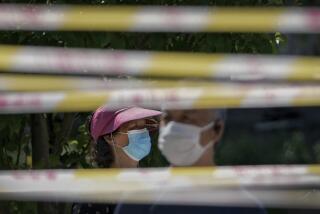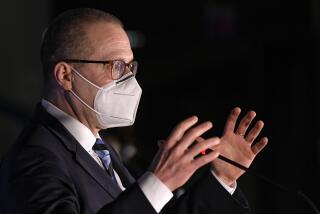U.N. Health Agency Alerts Travelers to Pneumonia Outbreak
- Share via
The World Health Organization on Saturday issued a rare emergency advisory cautioning travelers and airline employees to be on the alert for a severe form of pneumonia that has killed at least nine people and hospitalized hundreds of others, particularly in the Far East.
The advisory did not call for a halt in travel, but it warned travelers to be alert for the symptoms of the disease and to seek treatment immediately if such symptoms become apparent.
“We want people to be aware that if they have symptoms, they should go to a doctor and consider not traveling,” said WHO spokeswoman Christine McNab.
WHO said it has detected 150 new cases of the disease -- which it is calling severe acute respiratory syndrome, or SARS -- in the last week, and expressed alarm over the speed at which it is spreading into new areas.
Two deaths and several cases of SARS were reported in Canada last week, and Saturday, a Singaporean physician traveling from New York City was hospitalized in an isolation unit in Frankfurt, Germany, after falling ill on his flight. Some other people on the flight were quarantined in Germany.
Late Saturday, it was reported that another traveler, returning from Asia, had fallen ill aboard a flight from Atlanta to Canada.
“SARS is now a worldwide health threat,” Dr. Gro Harlem Brundtland, WHO’s director general, said in a statement. “The world needs to work together to find its cause, cure the sick and stop the spread.”
Officials stressed that there is no evidence the outbreak is linked to terrorism.
The U.S. Centers for Disease Control and Prevention activated its emergency operations center Friday and on Saturday began briefing state health officials about what to look for. To date, no cases have been identified in the United States.
“The emergence of two clusters of this illness on the North American continent indicates the potential for travelers who have been in the affected areas of Southeast Asia to have been exposed to this serious syndrome,” said Dr. Julie L. Gerberding, director of the CDC. “Therefore, we are instituting measures aimed at identifying potential cases among travelers returning to the United States and protecting people with whom they may have come in contact.”
Both WHO and CDC have sent teams of infectious disease experts and other physicians to Southeast Asia to help identify the cause of the outbreak and to assist in control efforts. The agencies are also sending masks, gowns, gloves, goggles and other hospital equipment to medical facilities to help break the transmission chain.
“We are doing everything humanly possible” to help halt the epidemic, Health and Human Services Secretary Tommy G. Thompson said Saturday.
More than half of the reported cases have involved hospital workers who have helped care for infected individuals. Three-quarters of the estimated 40 cases of SARS in Vietnam, for example, are in the Hanoi French Hospital, where a 48-year-old American businessman was treated after arriving in the city from Hong Kong. The American was evacuated back to Hong Kong and died Thursday.
Authorities fear that hospital workers will refuse to treat new patients because of the high risk of infection in hospital wards. Health agencies are now recommending so-called barrier nursing techniques, in which nurses and other personnel are physically separated from patients as much as possible.
SARS is an example of what authorities call an atypical pneumonia, a severe form of pneumonia that begins with fever, fatigue, shortness of breath and cough. So-called typical pneumonia usually causes only severe coughing and a fever. Most of the recent cases are progressing to acute respiratory distress syndrome, in which patents have severe difficulty breathing and must be placed on a respirator.
Atypical pneumonia is most often caused by bacteria such as Legionella pneumophila, Mycoplasma pneumoniae and Chlamydia pneumoniae, but it can also be caused by viruses. Researchers have not isolated any known or novel microorganism or virus from the infected patients and acknowledge that they are currently stumped about the cause of the outbreak.
The infection does not appear to respond to any antibiotics or antiviral agents that have been tried so far. Those patients who are kept alive by supportive care appear to eventually clear the infection on their own, but that appears to be a very slow process.
Although the number of deaths so far is relatively small, officials are moving rapidly to contain the outbreak because they fear a larger epidemic.
More to Read
Sign up for The Wild
We’ll help you find the best places to hike, bike and run, as well as the perfect silent spots for meditation and yoga.
You may occasionally receive promotional content from the Los Angeles Times.






